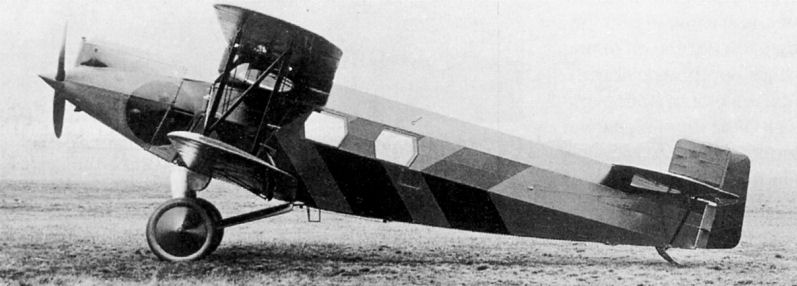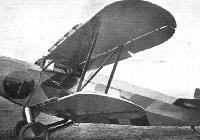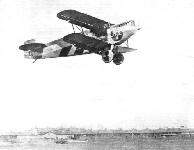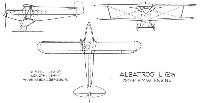Albatros L.72
Транспортный самолет Albatros L.72 проектировался в расчете на перевозку пяти человек - одного летчика и четырех пассажиров или летчика и различных грузов (в первую очередь - свежих газет и почты). Самолет представлял собой биплан с металлическим каркасом и полотняной обшивкой. За бипланной коробкой сечение фюзеляжа с ярко выраженными продольными гранями значительно увеличено в сравнении с сечением в носовой части. Площадь киля прямоугольной формы очень небольшая. Шасси типично для самолетов фирмы "Albatros" - трехопорное с хвостовым костылем. Мотор BMW полностью закрыт хорошо обтекаемым капотом, на втулку винта установлен кок.
Непосредственно за двигателем в фюзеляже под верхним крылом оборудована открытая кабина летчика. За ней находилась закрытая грузопассажирская кабина с четырьмя большими иллюминаторами. Если самолет предназначался для перевозки грузов, то в кабине ставились два откидных сиденья. В грузовом отсеке монтировались два лотка, в каждый из которых помещалось до 10 кг газет, листовок, либо пакетов с почтой. Этот груз мог сбрасываться в полете как по отдельности, так и одновременно, управление сбросом осуществлялось из кабины пилота.
ТАКТИКО-ТЕХНИЧЕСКИЕ ХАРАКТЕРИСТИКИ
Albatros L.72
Тип: легкий транспортный самолет
Силовая установка: поршневой двигатель с рядным расположением цилиндров BMW IV взлетной мощностью 300 л. с. (224 кВт)
Характеристики: максимальная скорость на уровне моря 160 км/ч; крейсерская скорость на оптимальной высоте 150 км/ч; практический потолок 3100 м
Массы: пустого 1345 кг; максимальная взлетная 2090 кг
Размеры: размах крыла 13,00 м; длина 10,50 м; высота 3,60 м; площадь крыла 44,50 м2
Полезная нагрузка: четыре пассажира или груз массой 320 кг
Показать полностьюShow all
Flight, April 1926
THE ALBATROS L 72A
A German Newspaper Carrier with Slotted Wings
IT is a somewhat peculiar fact that although the slotted aerofoil was invented in this country at least as early as it was in Germany, hitherto we have not had a single aeroplane fitted with slotted wings put on the regular air routes in order to test out by actual flying experience the merits of the device. It will, of course, be recollected that at about the same time that Mr. F. Handley Page discovered that extra lift could be obtained from an aerofoil by fitting it with slots of a certain shape, a German engineer, Dr. Ing. Gustav Lachmann, attempted to take out a patent in Germany for a similar device. Whereas the patent was granted to Mr. Handley Page in this and other countries, the original application by Dr. Lachmann was refused in Germany, because it was not considered that there was any reason to believe that such an arrangement would give extra lift. Later on the German Patent Office reconsidered this decision, and ultimately a patent was granted to Dr. Lachmann. Since that time Dr. Lachmann and the Handley Page company have, we believe, worked together amicably to mutual advantage, but it would appear that owing to official apathy in this country it has remained for Germany to bring out the first successful commercial aeroplane incorporating the slotted wing device. It is now some time ago that the Udet firm of Munich produced a cabin monoplane with slotted wings, but that machine was, we believe, regarded mainly as an experiment, and the mechanical gear for operating the auxiliary aerofoils was made somewhat heavier than it need have been, with the result that the utmost advantage was not gained from the provision of the slots. Now, however, a machine has been constructed by the Albatros works of Berlin-Johannisthal, one of the oldest of German aircraft firms, incorporating the Handley Page-Lachmann wing slots.
The new Albatros, which is known as the Type L 72a, has been constructed to the order of the famous German publishing firm Verlag Ullstein, and is to be employed for the rapid distribution of newspapers, for which purpose the machine has been specially arranged to allow parcels of newspapers to be shot overboard at suitable points, where the parcels are picked up and conveyed by ground transport to the distributing office.
The general lines of the Albatros L 72a are well brought out in the photographs and general arrangement drawings published herewith. The machine, it will be seen, is a normal tractor biplane, but is perhaps of rather unusually clean design, with but a single pair of inter-plane struts on each side, in spite of the relatively large span (42 ft.). The 220 B.M.W. engine is very neatly cowled in, and the sharp entry is further improved by fitting a pointed spinner over the propeller boss. The pilot is situated immediately under the top plane and aft of the pilot’s seat the roof of the fuselage rises steeply to meet the rear spar of the top plane. Notable features of the machine, apart from the fitting of leading edge slots and slotted ailerons, are the high aspect ratio and the great distance from trailing edge of main planes to leading edge of tail plane, which is in the neighbourhood of three chord lengths. Both are features which should assist efficiency and stability, although it may be admitted that owing to the use of but a single pair of inter-plane struts the angles of the wing bracing wires are somewhat small. These wires, by the way, are British streamline wires, a somewhat unusual feature on a German aeroplane.
Constructionally the Albatros L 72a is of the all-metal type, with a fuselage built of welded steel tubing, diagonally braced by wire and covered with fabric, while the wings have box spars of Duralumin and ribs of steel tubing, the covering again being in the form of fabric.
As regards the arrangement of the fuselage, the 220 h.p. B.M.W. engine is, as already mentioned, mounted in the extreme nose, and behind this is the cockpit for pilot and engineer. Aft of this again is a cabin having two windows in each side, and with two tip-up seats for those in charge of the distribution of the newspapers. Should the machine be required as a passenger-carrier, the arrangement for dropping newspapers can be removed and two extra seats substituted. Provision has also been made whereby the pilot, by pulling a lever situated in his cockpit, can discharge the newspapers at any desired moment, the arrangement provided including 16 compartments, each containing a parcel weighing 10 kilograms. An indicator is also fitted in the pilot's cockpit so that from this he can see how many parcels have already been dropped. At the moment it is not clear whether the two tip-up seats in the cabin are intended for occasional passengers, but the fact that provision has been made for enabling the pilot to drop the newspapers without aid from anyone in the cabin rather points to this being the case.
The wing construction is, as already stated, of all-metal type, except for the doped fabric covering. The upper and lower wings are identical, as are also the fittings at their roots, so that one spare wing can be used in the top plane or bottom plane as required, the centre section of the top plane having fittings to receive the wings identical with those on the bottom longerons. The section used in the wings is a semi-thick one, and except for the elliptical rounding off of the wing tips, there is no change in chord or thickness from root to some distance outside the points of strut attachment. The slotted wings incorporate the latest type of leading edge slot in which the auxiliary aerofoil is in the form of a thin Duralumin strip which lies snugly against the leading edge when the slot is closed. The ailerons, or rather trailing edge flaps, are also slotted and are pivoted in such a way that with the trailing edge flaps down 24° the flap slot is open. The outer portion of the trailing edge flaps is retained as differential ailerons for lateral control.
Like the rest of the machine the tail surfaces are of metal construction, the material used in this case being steel tubing, although the spar of the trimming tail plane is of Duralumin. A novel feature is found in the rudder and fin, both of which are pivoted, and in such a manner that when the rudder moves to one side, the fin also pivots around a vertical axis. The object of this arrangement is to get a more powerful rudder control with smaller angular movement, and wind tunnel experiments at Gottingen appear to indicate that the increased effectiveness of the rudder obtainable by this arrangement is of the order of 40 to 50 per cent.
The undercarriage is of the Oleo pneumatic type, the landing shocks being absorbed by the compression of the air in the undercarriage cylinder and bouncing being damped by a normal type of Oleo gear.
It will be observed that the centre section of the top plane is rather thicker than the rest of the wings. This is accounted for by the fact that the centre section forms the main petrol tank, or rather tanks, there being two. As a result of this . placing of the tanks direct gravity feed is possible and the capacity of the tanks is such as to give the machine a duration of 4 1/2 hours at cruising speed.
The main dimensions of the Albatros L.72a are shown on the general arrangement drawings. The weight of the machine empty is 1,300 kg. (2,860 lbs.), and the useful load is 700 kg. (1,540 lbs), giving a total loaded weight of 2,000 kg. (4,400 lbs.). As the wing area is 36 sq. m. (387-5 sq. ft.) the wing loading works out at the rather high figure of 11-35 lbs./sq. ft. With the particular wing section employed the landing speed is stated to be 110 km. per hour (62-2 m.p.h.) but with slots open this figure is reduced to 75 km. per hour (46-6 m.p.h.), so that it would appear that the provision of the slots has been very well worth while. The top speed of the machine is given as 180 km. per hour (112 m.p.h.), and the cruising speed as 170 km. per hour (105 m.p.h.).
Показать полностьюShow all






